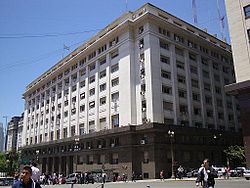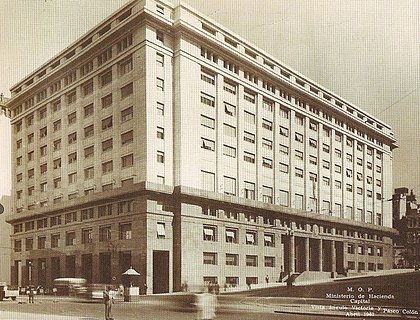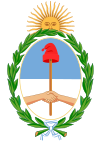
The Casa Rosada is the executive mansion and office of the President of Argentina. The palatial mansion is known officially as Casa de Gobierno,. Normally, the President lives at the Quinta de Olivos, the official residence of the President of Argentina, which is located in Olivos, Greater Buenos Aires. The characteristic color of the Casa Rosada is baby pink, and is considered one of the most emblematic buildings in Buenos Aires. The building also houses a museum, which contains objects relating to former presidents of Argentina. It has been declared a National Historic Monument of Argentina.
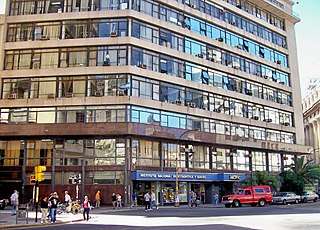
National Statistics and Censuses Institute is the Argentine government agency responsible for the collection and processing of statistical data. The institute also analyses economic and social indicators such as inflation rate, poverty rate and unemployment, among others.
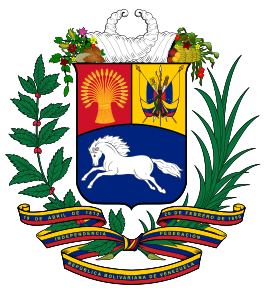
The Cabinet of Ministers of Venezuela (Spanish: Gabinete de Ministros de Venezuela is one of the bodies that make up the Venezuelan executive in that country's presidential system, alongside the Council of Ministers. The Cabinet is headed by the President of Venezuela, and his corresponding Vice President. The purpose of the ministries is to create, adopt, follow and evaluate policies, strategies, programs and projects in accordance with the constitution and the laws of the Republic.

The Ministry of Foreign Affairs and Worship is the Argentine government ministry which oversees the foreign relations of Argentina.

Mercedes Rosalba Aráoz Fernández is a Peruvian economist, professor, and politician.

The Directorate-General for Insurance and Pension Funds (DGSFP) is the Spanish government's financial regulatory department that supervises and controls Spain's insurance and pension fund sector.
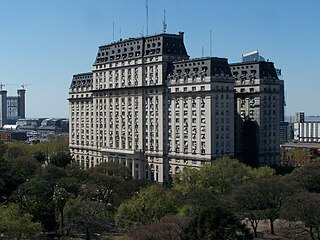
The Libertador Building is a government building in Buenos Aires, Argentina, housing the Ministry of Defense.

The Buenos Aires Customs House (Aduana) is a government building and architectural landmark in the Montserrat section of Buenos Aires.

The National Academy of History of the Argentine Republic is a non-profit learned society established to foster the study and dissemination of Argentine history.
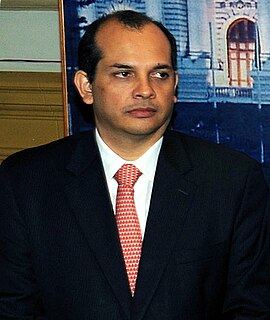
Luis Miguel Castilla Rubio is a Peruvian economist and politician. He was the Minister of Economy and Finance of Peru, serving under President Ollanta Humala.
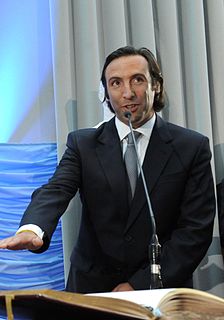
Hernán Gaspar Lorenzino is an Argentine lawyer and public policy maker. He was appointed Minister of Economy of Argentina by President Cristina Kirchner in 2011.

The Ministry of Economy and Finance, is a ministry of the Italian government. Its responsibilities include overseeing economic policy, public investments and spending. The Ministry's headquarters are located in the historic Palazzo delle Finanze. The current minister is Roberto Gualtieri of Conte II Cabinet.

Industry was in 2012 the largest single sector in Argentina's economy, with a 20.3% share of GDP. Well-integrated into local agriculture, half of the industrial exports have rural origin.

The Ministry for the Economy, Development, and Tourism is a Chilean state ministry in charge of planning and executing the flow of policies and projects of the Chilean government. The ministry aims to generate feasible and sustainable economic development, with stable progressive equality in the allocation of economic interests. The current Minister of Economy, Development, and Tourism is José Ramón Valente Vias.

Empresa Argentina de Soluciones Satelitales Sociedad Anónima AR-SAT, usually known simply as ARSAT, is an Argentine government-owned telecommunications company incorporated in 2006 as a Sociedad Anónima through the federal law 26.092. At the time of incorporation, its ownership was shared by the Ministry of Federal Planning, Public Investment and Services (98%) and the Ministry of Economy and Public Finances (2%).

The Ministry of Finance or Ministry of Treasury (MH) is the department of the Government of Spain responsible responsible for planning and carrying out the government policy on public finance and budget and it applies and manages the regional and local financing systems and the provision of information on the economic-financial activity of the different Public Administrations.
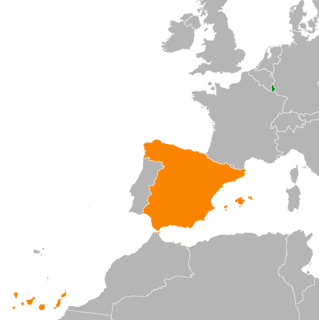
Luxembourg–Spain relations are the bilateral and diplomatic relations between these two countries. Relationships are mainly defined by the membership of both countries to the European Union and to NATO. Luxembourg has an embassy in Madrid and seven consulate s in Alicante, Barcelona, Bilbao, Las Palmas de Gran Canaria, Málaga, Palma de Mallorca and Seville. Spain has an embassy in Luxembourg City.
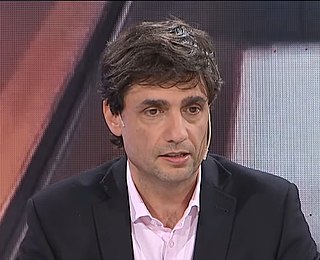
Jorge Roberto Hernán Lacunza is an Argentine economist, appointed in 2019 as Minister of the Treasury of the Mauricio Macri administration.
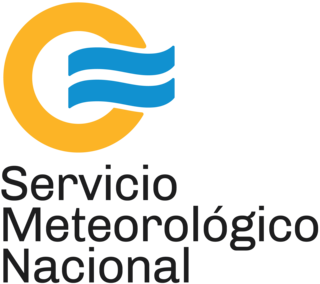
The Servicio Meteorológico Nacional (SMN) is Argentina's national weather service under the Ministry of Defense that is tasked with observing, understanding, and predicting the weather and climate in Argentina and its surrounding waters. It provides weather forecasts, radar images, ozone, temperature and rainfall graphs, and satellite images. The purpose of these tasks is to contribute to protection of its inhabitants, sustainable economic development and to provide representation of Argentina to international meteorological organizations. Founded on 4 October 1872 by Federal law Nº559 during the presidency of Domingo Faustino Sarmiento, the organisation was the first meteorological organisation in South America and the third one in the world, after Hungary and the United States which were created in 1870 and 1871 respectively. It became a member of the World Meteorological Organization on 2 January 1951. Throughout its history, the organisation was dependent under different government ministries until in 2007 when it is currently under the Ministry of Defense.

The 2019–20 coronavirus pandemic was reported to have spread to Ecuador on 29 February 2020 when a woman in her 70s tested positive for the virus.

